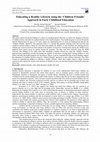Papers by Maziah Ahmad Marzuki
This is an Open Access article distributed under the terms of the Creative Commons Attribution-No... more This is an Open Access article distributed under the terms of the Creative Commons Attribution-Noncommercial 4.0 Unported License, permitting all non-commercial use, distribution, and reproduction in any medium, provided the original work is properly cited.
Psychology & Neuroscience

Jurnal Sains Kesihatan Malaysia
A food premise's sanitation level can be reflected by the cleanliness of its food contact surface... more A food premise's sanitation level can be reflected by the cleanliness of its food contact surfaces. Contaminated food contact surfaces along with poor handling methods by food handlers may increase the risk of foodborne diseases through cross-contamination events. This study aimed to assess the microbiological contamination levels on food contact surfaces of 12 residential college cafeterias in a local university and its correlation with the cafeteria's premise grade. The presence of selected indicator and pathogenic microorganisms (total viable count (TVC), total coliform, Escherichia coli, Staphylococcus aureus, Salmonella spp., and Shigella spp.) on food contact surfaces were also determined. Cutting boards, knives and utensils (cutleries, bowls and plates) that were used for ready-to-eat food were sampled for this study. The cafeteria's premise grade was obtained based on the food premise inspection report by the university Health Centre. Three cafeterias have significantly higher (p < 0.05) bacterial counts (TVC) as compared to the international standard (1 log CFU/cm 2). E. coli was only found in 2 cafeterias while Salmonella spp. was only detected on 7 of the cafeterias. Cutting boards were identified as the most contaminated food contact surface whereas utensils were the least contaminated. There was only a weak correlation between the microbiological levels on food contact surfaces and the cafeteria's inspection grade (r = 0.02 p > 0.01). This study demonstrated that the sanitation level of food contact surfaces in the residential college cafeterias was only average. Improvements need to be done to increase the sanitation level of the cafeterias, thus assuring the safety of the food for consumers.

Journal of Education and Practice, 2014
This paper reports the partial findings of a study on a health program that aims to explore the c... more This paper reports the partial findings of a study on a health program that aims to explore the changes in lifestyle of children before and after the implementation of the health program. This health program involved 40 parents and 40 children from the ages of 3-6 years, which was implemented for 32 weeks in kindergartens that use the 'children friendly' approach. This approach refers to a concept that prepares learning notes and activities that comprises special features, which are well liked and suitable for children. It also facilitates the learning process without any coercion involved. Data related to the number of television viewing hours among the children were gathered from reports given by parents during the program. The data were then analysed using the SPSS software. The findings of the study show that educating a healthy lifestyle by using the 'children friendly' approach had contributed towards decreasing the number of television viewing hours among children as seen before and after the health program was introduced. Hence, it can be concluded that the research findings support the educating of a healthy lifestyle using the 'children friendly' approach in early children education. This effort focuses on engendering children to cultivate a healthy lifestyle, which then enables them to obtain learning experience that satiates the instinct and emotions of children to carry on learning and practicing health conscious behaviour.

Asian Social Science, 2015
This article discusses the contribution of 'child-friendly' learning environments in an obesity p... more This article discusses the contribution of 'child-friendly' learning environments in an obesity prevention health education program for young children. The 'child-friendly' approach refers to a concept wherein the situation, place, as well as the activities conducted include elements that children like or enjoy and are suitable to their level. A total of 68 children between the ages of 3-6 years participated in the study. The program was conducted for 32 weeks at a kindergarten using a 'child-friendly' approach. Data regarding children's reactions towards the approach were collected using video recordings and anecdotal records from in-situ observation. The data were analyzed using ATLAS.ti. Research results show that the 'child-friendly' learning environment contributed four positive reactions from the children; 94.29% of the children were recorded to be 'happy', 90.02% were recorded to be 'excited', 98.59% showed 'acceptance' and 95.71% showed 'appreciation'. In conclusion, the research findings support the use of the 'child-friendly' approach in the teaching and learning process of children aged between 3-6 years as they are able to experience learning in an enjoyable manner thus motivating them to learn.
Procedia - Social and Behavioral Sciences, 2012
Teaching and learning of medical sciences in nursing was identified as the cause of anxiety among... more Teaching and learning of medical sciences in nursing was identified as the cause of anxiety among students, teachers and the organizations. The aim of this study was to determine the difficulties faced by nursing students in those modules. An action research was conducted on 1st and 2nd year of Bachelor of Nursing students. Results showed that, relationship between CGPA, students' guide book (p= 0.021, 0.018), lectures timetable (p =0.032), lectures (p=0.034, 0.043) and learning package (p=0.008, 0.016) of physiology and biochemistry influenced the teaching and learning of medical science subjects.
Continuing Nursing Education (CNE) within the Nursing Practice Environment (NPE) is important in ... more Continuing Nursing Education (CNE) within the Nursing Practice Environment (NPE) is important in determining issues associated with unsafe practice, unproductiveness or incompetent nurses. A descriptive correlational study was designed to determine the best practice initiative in NPE whereby 395 (94.3%) nurses participated. This study showed that the highest mean score was 2.91 on 'Nursing Foundations for Quality of Care' of which 314 (79.5%) nurses highly agreed that CNE programs are the most important. In conclusion, CNE program is the best practice initiative and it is recommended that CNE will encourage lifelong and transformational learning in the nursing career.











Uploads
Papers by Maziah Ahmad Marzuki